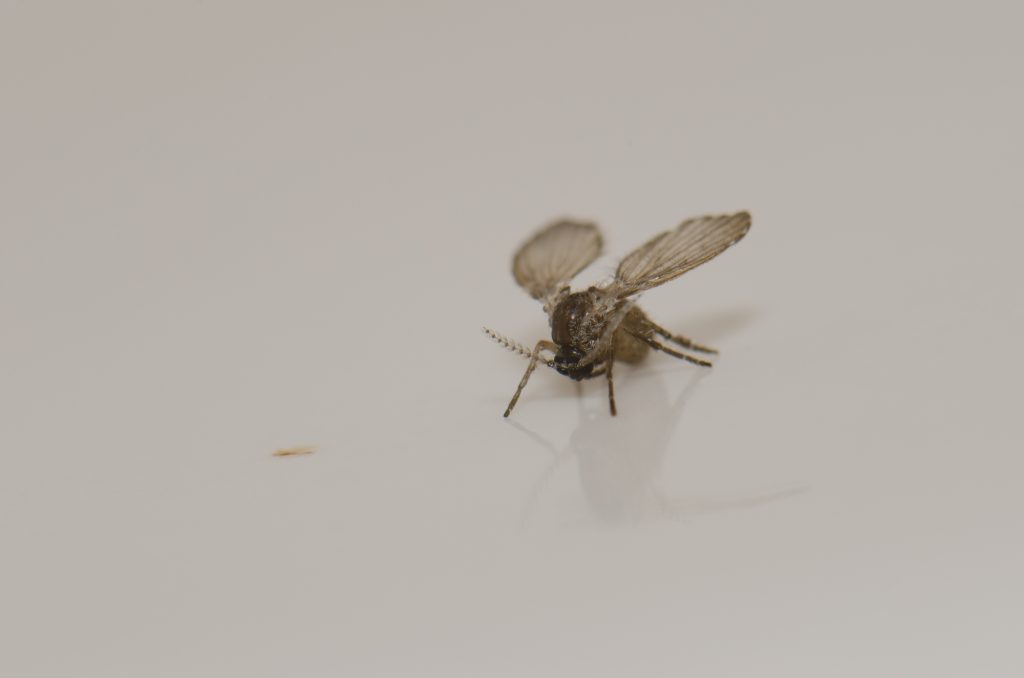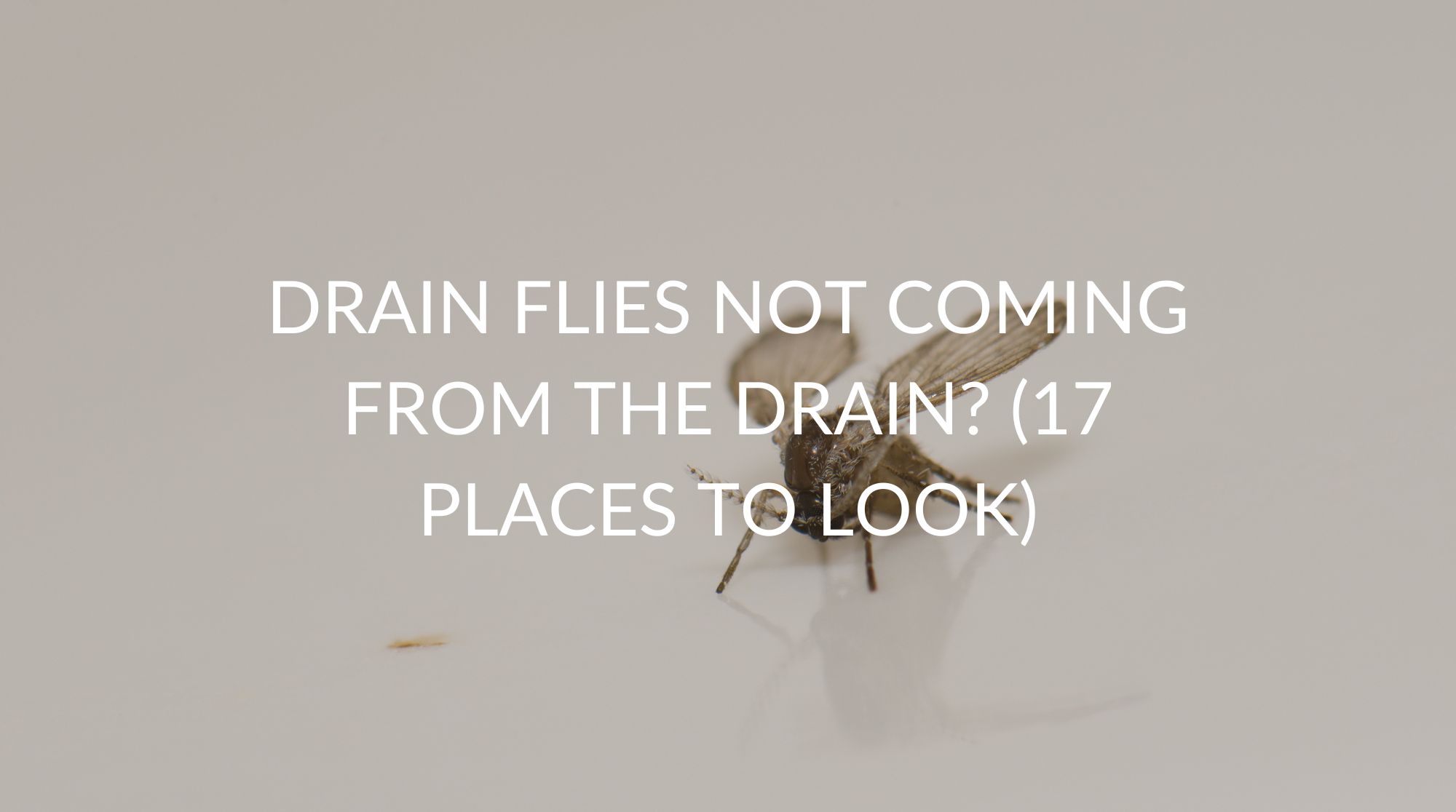You may have removed all the drain flies from your drains, only to notice that somehow they’re still coming back! In this article, you’re going to find out why you may still have drain flies even when they’re not coming from your drain, how to locate the main sources, and the common causes of drain fly infestations.
So keep reading to find out everything you need to know!
So Why Aren’t Drain Flies Coming From Your Drain?
You may not have realized this, but drain flies don’t actually come up from the depths of your drain. In fact, they’re normally drawn in from outside when they can smell rotten organic matter. They’re much more active in the evening, and it’s during this time that they’ll look for a new home in your sinks and drains.
How To Locate The Source
Now you know that it’s entirely probable that the drain flies aren’t coming from the drain itself, the next step is to locate the main source of the flies. And remember, they could be coming from multiple places. So to get rid of them permanently, not only will you need to find all the sources, but you’ll also need to destroy them, the drain flies, the larvae, and the eggs too!
Common Places To Find Drain Flies
This may feel like an impossible task; however, with the help of this article, you’ll have plenty of ideas on where the drain flies could be coming from. Before you have ideas on where to look, it’s important to know what drain flies look for when choosing a place to breed.
- The first need a drain fly has is a need for moist areas. This is why they favor your sinks and homes so much. However, just as they favor these areas, it’s also important to look outside.
- They also like areas that have a lot of organic build-ups as well. These are the perfect places for them to breed in.
- They’ll also look for areas that are shaded as well, which is why they favor your drains and sinks.
With that being said, here are all the places you can find drain flies.
Sinks And Drains
Okay, this one is obvious. But one of the most common spots to find drain flies are in the sinks and drains around your house. A quick way to know if the pipe is infested with drain flies is to place some duct tape over the opening. Leave it overnight, and if you notice that drain flies are stuck to it, then you know you have some in your pipe!

Floor Drain
If you have a floor drain in your home, then you should also check it for drain flies as well. Use the same duct tape method as before to see if that’s where the drain flies have come from!
Sink Overflow
There’s no point removing the drain flies from the pipes if you forget to check the sink overflow. It’s more than possible that some drain flies may have migrated up to this area of your sink when breeding, so you’ll need to check there as well.
The Sump Pump
It’s also entirely possible for drain flies to come from your sump pump. The standing water and dark create a great environment for them to live in. (Here’s what to do if you think that drain flies are coming from your sump pump.)
Potted Plants
It’s hard to think that your potted plants might be behind the drain flies; however, moist soil is a great breeding ground and home for them. So make sure you’re looking into all of your plants when trying to figure out where the pests are coming from.
And while the larvae of the plants will feed on the roots, the good news is they won’t cause too much damage.
Toilet Tank
You should also check your toilet tank to make sure that drain flies haven’t made their way in there, especially if the toilet tank has been unused for a while. If the tank hasn’t been flushed regularly, or you haven’t cleaned the tank itself in a while, then it could also be behind the drain fly infestation.
Garbage Disposal
There are few places more ideal for drain flies than your garbage disposal. Not only does it have an abundance of rotting organic matter down it, but it’s also dar with plenty of standing water as well. So if you notice drain flies coming from some of your pipes, you’re definitely going to want to check your garbage disposal as well.
Septic Tank
You may also want to check your septic tank to make sure drain flies haven’t gotten in there. While it’s not the most pleasant job in the world, it’s definitely somewhere you’ll need to look at. Even a septic tank that is slightly unsealed is enough for drain flies to get in.
Under Loose Tiles
Have you got any loose tiles in your bathroom or kitchen? If so, you should take a look under them. It’s more than possible that drain flies have made their nests there.
Leaky Shower Pans
Leaky shower pans are another prime location for drain flies. Especially if the water is dripping underneath the shower, so, try to fix the issue as soon as possible. Even if there aren’t drain flies there yet, it’s only a matter of time before there will be.
Bird Baths
If you’ve been treating the birds outside your house to a birdbath, then it may be time to check the water. Especially if the birdbath just houses standing water.
Rain Barrels
If you’ve been using rain barrels to store water for your plants, then you should also look inside them.
Open Trash Areas
Any area with open trash or garbage is also going to be a prime location for drain flies to live and breed. You’ll find this to especially be the case in the garbage where thick sludge has formed, or bin juice has accumulated.
Crawl Spaces
There’s also a chance that drain flies could be in your crawl spaces, especially if you suspect that water is somehow leaking into them.
Yard Mulch
Any decomposing yad mulch or compost you’re trying to create is also going to be the perfect spot for drain flies to live and breed as well.
Clogged Roof Gutters
Just another reason you should make sure you’re keeping your roof gutters clean. If you notice the gutter is clogged, especially with leaves, etc., then there’s a good chance that drain flies could be breeding there.
Around Your Air Conditioning Units
And lastly, you should also check around your air conditioning units as well. The condensation line and condensation pan can often contain a build-up of water (when something’s wrong with the unit), so it’s well worth checking these too.
More Drain Fly Inspection Tips
Now you know all the places that drain flies may be breeding, here are some more tips you should follow when looking for the pests.
Look Deep
First of all, a lot of the time, drain flies and their larvae may not be on the surface of the places you’re looking. You’ll need to dig in a bit to see if the larvae are there. And then, if you see any larvae or adults, you’ll know this is an area infested with drain flies.
There May Be Multiple Sources
It’s also important to know that there may be more than one location that the drain flies are coming from. So just because you notice drain flies in one place, you should still continue looking in other areas as well.
Look For Areas Sealant Or Grouting Is Bad
You should also look in areas where sealant or grouting is beginning to fall apart. When you notice these areas, inspect them for drain flies. Once you know they’re clean, you should then refill them to prevent drain flies from heading there again in the future.
Think Outside The Box
And lastly, make sure you’re thinking outside the box on where you think drain flies might be. They can often be found in the strangest places.
Eggs And Larvae May Have Survived
Even in times when you think you’ve destroyed all the drain flies, it may be the case that the larvae or eggs may have survived. So the original place you found them may have started harboring them again. This is one of the reasons you should check the areas you’ve cleaned multiple times to make sure the issue has been fixed permanently.
Make Sure You’re Not Confusing Drain Flies With Other Insects
You should also make sure you’re not confusing drain flies with other insects either. If you’re trying and trying to remove drain flies from your home, then it might not even bet them, to begin with. Oftentimes, people can mistake drain flies for fruit flies, fungus gnats, and even small house flies.
Fortunately, there are a few ways you can spot drain flies. So look for the following and be certain they’re what you’re dealing with:
- They’ll normally tan to light gray in color.
- Their body and wings are covered with long hair, so they’ll look fuzzy in appearance.
- If you swat one, the wings will turn to fine dust.
- When they’re disturbed, they’ll only move a short distance instead of flying all around the room.
- When they’re fully grown, the adults will be about 1/16th of an inch in length.
Recap
As you can see, there are a whole bunch of places drain flies and their larvae may be lurking. If you want to remove them all from your home, then thinking outside of the box is going to be the key to doing so!
And if you found this article helpful, make sure you check out the rest of the website. Otherwise, have a great day.


